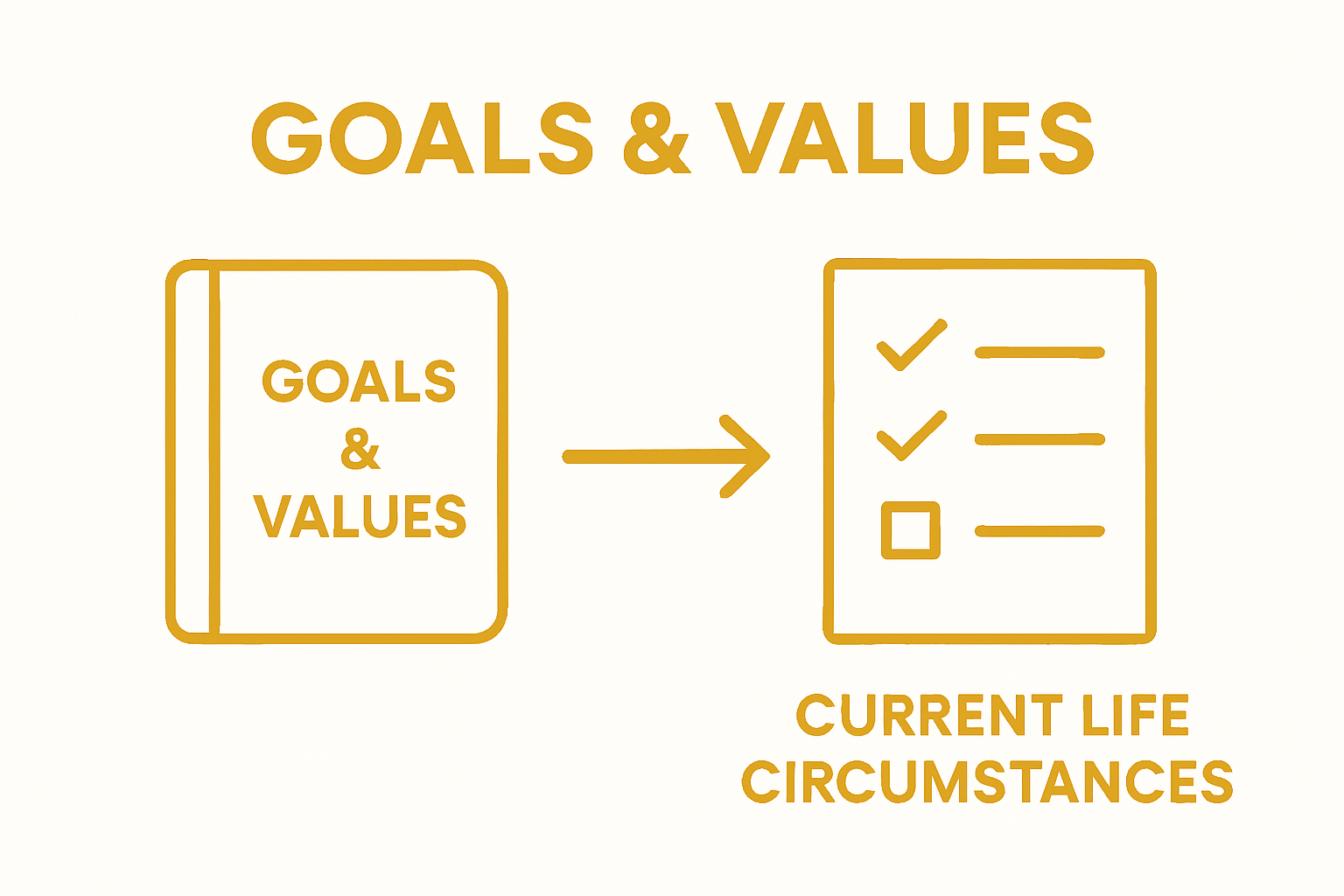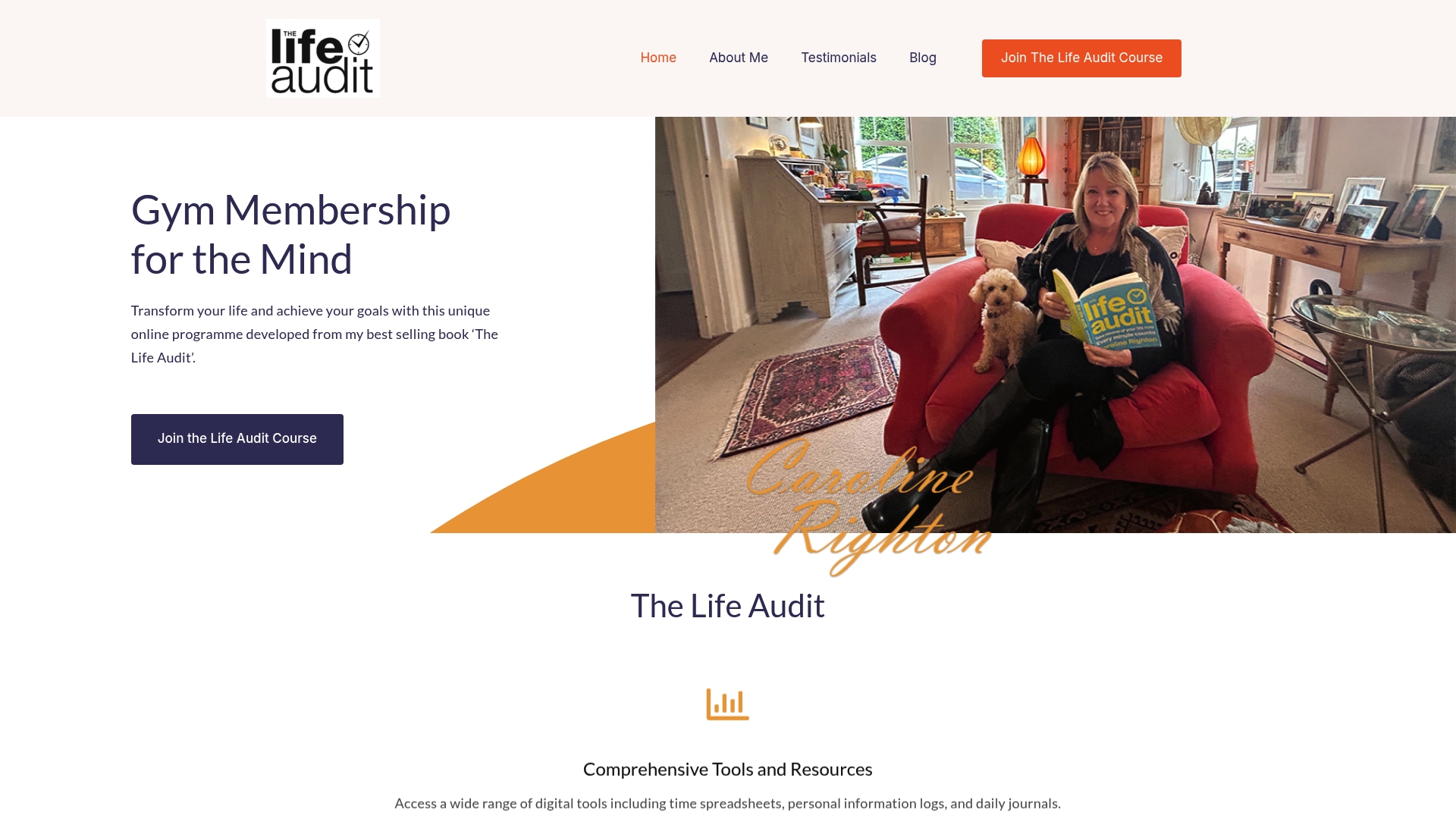Setting big life goals sounds inspiring. Most people believe bold dreams and detailed plans are what drive deep personal change. Yet, studies show something unexpected. Self-reflection is actually your most powerful tool for real transformation. The hardest part is not just making lists but discovering what you truly want and why.
Table of Contents
- Step 1: Define Your Life Goals And Values
- Step 2: Evaluate Your Current Life Circumstances
- Step 3: Identify Areas For Improvement And Growth
- Step 4: Develop An Action Plan For Change
- Step 5: Implement And Monitor Your Progress
- Step 6: Reflect And Adjust Your Strategies As Needed
Quick Summary
| Key Point | Explanation |
|---|---|
| 1. Define your life goals and values | Understand what truly matters to you to create a roadmap for your future. |
| 2. Evaluate your current life circumstances | Conduct a thorough assessment of your present situation to identify areas for improvement. |
| 3. Identify specific areas for growth | Pinpoint skills and mindsets that need development to align with your goals. |
| 4. Develop a detailed action plan | Create a structured strategy with specific, measurable objectives to achieve your growth. |
| 5. Regularly implement and monitor progress | Consistently track your development and adjust strategies based on feedback and insights. |
Step 1: Define Your Life Goals and Values
Defining your life goals and values is the foundational blueprint for meaningful personal transformation. This initial step is about understanding who you are, what matters most to you, and creating a clear roadmap for your future. Self-reflection becomes your most powerful tool in this journey of personal discovery.
Begin by creating a quiet, uninterrupted space where you can truly connect with yourself. Take a blank journal or digital document and start exploring your inner landscape. Ask yourself profound questions: What experiences have shaped my core beliefs? What moments have brought me genuine joy and fulfilment? What principles do I absolutely refuse to compromise?
According to research published in Psychological Reports, structured self-reflection significantly enhances our ability to identify meaningful life goals. Your goal is to uncover values that are authentically yours, not inherited from family, society, or external expectations.
As you explore, categorise your reflections into different life domains: personal growth, relationships, career, health, spirituality, and contribution to society. For each domain, articulate what success and fulfilment truly mean to you. Be brutally honest with yourself. This isn’t about creating an idealised version of your life, but understanding your genuine aspirations.
Verify your progress by checking if your defined goals meet these key criteria:
- They resonate emotionally and intellectually
- They feel challenging yet achievable
- They align with your core values
- They inspire and motivate you
Remember, this process isn’t about perfection but about creating a dynamic, evolving understanding of yourself. Your goals and values will naturally shift and mature over time, so approach this step with curiosity and compassion towards yourself.
Below is a checklist table summarising the key verification criteria for assessing whether your defined life goals truly align with your values.
| Verification Criterion | Description |
|---|---|
| Emotional and Intellectual Resonance | Goals evoke a strong personal response and feel relevant. |
| Challenging Yet Achievable | Goals stretch your abilities but remain realistically attainable. |
| Alignment with Core Values | Goals reflect your authentic beliefs and priorities. |
| Inspire and Motivate | Goals stimulate enthusiasm and ongoing commitment. |
Step 2: Evaluate Your Current Life Circumstances
Evaluating your current life circumstances is a critical diagnostic process that transforms abstract aspirations into tangible insights. This step bridges the gap between your defined goals and your present reality, revealing precise areas requiring transformation.

According to research published in Frontiers in Psychiatry, comprehensive life evaluation involves examining multiple interconnected domains: personal well-being, economic status, relationships, professional development, health, and emotional landscape. Begin by creating a comprehensive personal audit that captures your current state with surgical precision.
Start with a holistic personal inventory. Grab a dedicated journal or digital document and systematically document your current circumstances across key life domains. For each area, answer penetrating questions: What is working exceptionally well? Where do significant gaps exist between your current reality and your aspirational goals? What recurring patterns or obstacles consistently prevent you from achieving your desired outcomes?
Quantify your observations wherever possible. Instead of vague statements like “I’m not satisfied with my career,” document specific metrics: current income, job satisfaction rating, skill development progress, professional network strength. Concrete measurements transform subjective feelings into actionable intelligence.
Your evaluation should include a transparent, unvarnished assessment of both external circumstances and internal psychological states. Recognize that your perception shapes your reality.
The table below provides an overview of core elements to evaluate when conducting a comprehensive assessment of your current life circumstances across major domains.
| Life Domain | Key Questions to Explore |
|---|---|
| Personal Growth | What recent developments am I proud of? Where do I feel stuck? |
| Relationships | Are my connections supportive? Where is there tension or distance? |
| Career | Am I satisfied in my role? What progress have I made professionally? |
| Health | Is my physical and mental health where I want it to be? |
| Spirituality | Do I feel connected to a greater purpose? |
| Contribution | How am I giving back to my community or society? |
| Some challenges are practical and measurable, while others are psychological and require deeper introspection. |
Verify the comprehensiveness of your evaluation by ensuring you’ve addressed these critical aspects:
- Documented current status across all major life domains
- Identified specific gaps between current circumstances and desired goals
- Captured both objective measurements and subjective experiences
- Noted potential internal and external barriers to progress
Remember, this evaluation is not about self-criticism but about generating compassionate, strategic insights that will fuel your transformative journey.
Step 3: Identify Areas for Improvement and Growth
Identifying areas for improvement and growth transforms your life audit from passive reflection into active strategic planning. This critical step bridges the gap between understanding your current circumstances and creating meaningful change. Your ability to critically and compassionately assess your potential will determine the trajectory of your personal development.
According to resources from the Open University, a structured approach to personal development is essential for targeted growth. Begin by cross-referencing the goals you established in Step 1 with the comprehensive evaluation from Step 2. Look for specific misalignments, recurring patterns, and systemic limitations that have prevented you from achieving your desired outcomes.
Approach this process with radical honesty and gentle self-compassion. Your goal is not to criticize yourself but to understand your growth opportunities. Examine each life domain through a lens of potential rather than deficiency. What skills, mindsets, or resources could dramatically accelerate your progress? Where are the most significant leverage points for transformation?
Consider creating a personal development matrix that categorizes potential growth areas. This might include technical skills, emotional intelligence, physical health, relationship dynamics, financial literacy, or spiritual development. For each identified area, articulate not just the current limitation but the specific positive outcome you desire. Transformation begins with clarity and intentionality.
Your improvement identification process should be both introspective and externally informed. Seek feedback from trusted mentors, colleagues, or personal development professionals who can offer objective perspectives on your blind spots and untapped potential.
Verify the comprehensiveness of your improvement identification by ensuring you’ve addressed these critical aspects:
- Documented specific growth opportunities across multiple life domains
- Linked improvement areas directly to your core goals and values
- Identified both skill-based and psychological/emotional development needs
- Created measurable and specific improvement objectives
Remember that personal growth is not a linear journey but a dynamic, iterative process of continuous learning and self-discovery. Your willingness to remain curious and open to change is your most powerful development tool.
This table summarises the process for identifying and verifying areas for improvement and growth within your life.
| Improvement Area Criteria | How to Address |
|---|---|
| Specific Growth Opportunities | Document concrete areas needing development |
| Direct Link to Goals & Values | Ensure growth targets support your aspirations |
| Skill-Based and Emotional Development | Identify both technical and psychological needs |
| Measurable Objectives | Set clear, actionable targets for each improvement |
Step 4: Develop an Action Plan for Change
Developing an action plan transforms your aspirational goals into executable strategies. This pivotal step converts introspection into tangible momentum, creating a structured roadmap for personal transformation. Your action plan is the bridge between contemplation and meaningful change.
According to research examining health behavior change strategies, effective action plans must be personally conceived, precisely articulated, and regularly reevaluated. Begin by translating the improvement areas identified in previous steps into specific, actionable objectives. Each goal requires granular breakdown into manageable, incremental actions that feel both challenging and achievable.
Construct your action plan with surgical precision. For each identified growth area, develop a clear strategy that includes specific milestones, required resources, potential obstacles, and contingency approaches. Consider creating a visual representation of your plan – perhaps a mind map or structured spreadsheet that allows you to track progress and maintain accountability.
Implement a time-sensitive framework for your objectives. Short-term goals (1-3 months) should serve as stepping stones towards more comprehensive medium-term (6-12 months) and long-term (1-3 years) transformations. This multi-tiered approach prevents overwhelm while maintaining strategic focus. Break complex goals into weekly or monthly actionable tasks that can be consistently executed and monitored.
Integrate robust accountability mechanisms into your action plan. This might involve sharing your goals with a trusted mentor, joining a support group, or utilizing digital tracking tools that help you monitor progress. External accountability dramatically increases the likelihood of sustained change.
Verify the effectiveness of your action plan by ensuring it meets these critical criteria:
- Includes specific, measurable objectives across identified improvement areas
- Contains realistic timelines with clear milestones
- Identifies potential obstacles and corresponding mitigation strategies
- Incorporates flexible review and adjustment mechanisms
Remember that an action plan is a living document. Approach it with curiosity, adaptability, and compassionate self-accountability. Your willingness to consistently refine and recommit is more important than initial perfection.
Below is a table outlining essential components to include in a robust action plan for change, as discussed in Step 4.
| Action Plan Component | Purpose/Description |
|---|---|
| Specific Objectives | Clear goals broken into actionable tasks |
| Realistic Timelines | Defined deadlines and milestones for each step |
| Potential Obstacles | Recognition of challenges with plans to mitigate them |
| Accountability Mechanisms | Structures for tracking progress and ensuring follow-through |
| Review & Adjustment | Built-in points to assess and refine your approach |
Step 5: Implement and Monitor Your Progress
Implementing and monitoring your progress transforms your carefully crafted action plan from a theoretical document into a dynamic, living strategy for personal transformation. This step is where intention meets execution, and potential becomes reality. Your commitment to consistent, compassionate self-observation will determine the sustainability of your growth journey.
According to research in BMC Public Health, effective behavior change relies on robust monitoring and adaptive feedback mechanisms. Begin by establishing a systematic tracking method that allows you to observe your progress with both objectivity and empathy. This might involve creating a dedicated progress journal, using digital tracking applications, or developing a visual dashboard that captures your advancement across different life domains.
Implement a weekly review ritual where you comprehensively assess your progress. During these sessions, move beyond simple metric tracking. Examine not just what you’ve accomplished, but how these accomplishments feel. Are your actions aligned with your core values? Are you experiencing genuine growth, or merely executing tasks? Reflect on the emotional and psychological shifts accompanying your external progress.
Anticipate and plan for potential obstacles. Successful implementation isn’t about perfection but about resilience and adaptability. When you encounter challenges, view them as valuable information rather than failures. Each setback provides critical insights that can help you refine your approach. Develop a flexible mindset that sees deviation from the original plan not as a roadblock, but as an opportunity for creative problem-solving.
Create multiple layers of accountability. This could involve sharing your progress with a trusted mentor, joining a supportive community of individuals with similar goals, or working with a professional coach who can provide objective guidance and perspective.
Verify the effectiveness of your implementation and monitoring process by ensuring you’ve addressed these critical aspects:
- Established consistent, regular progress tracking mechanisms
- Created space for honest self-reflection beyond mere numerical metrics
- Developed adaptive strategies for managing unexpected challenges
- Maintained emotional engagement with your growth process
Remember that monitoring is not about judgment, but about compassionate understanding. Your willingness to observe yourself with curiosity and kindness is the most powerful tool in your transformational toolkit.
Step 6: Reflect and Adjust Your Strategies as Needed
Reflection and strategic adjustment are the heartbeat of sustainable personal transformation. This critical step transforms your change journey from a rigid plan into a fluid, responsive process of continuous growth. Your ability to reflect honestly and adapt courageously will determine the depth and longevity of your personal development.
According to research from the National Institutes of Health, effective self-reflection involves more than passive observation. It requires a structured, compassionate approach that balances analytical assessment with emotional intelligence. Create a dedicated reflection practice that goes beyond surface-level progress tracking.
Establish a comprehensive reflection ritual that occurs monthly or quarterly. During these sessions, conduct a holistic review of your progress across all life domains. Examine not just what you’ve accomplished, but the underlying patterns, emotional landscapes, and unexpected insights that have emerged during your transformation journey. Ask yourself penetrating questions: What strategies have genuinely resonated with my core values? Where have I experienced unexpected resistance or breakthrough?
Approach your reflection with radical honesty and gentle self-compassion. Recognize that adjustment is not a sign of failure, but a testament to your commitment to growth. Some strategies will work brilliantly, while others may require significant recalibration. Your willingness to release what no longer serves you is as important as your determination to pursue your goals.
Develop a systematic approach to strategy adjustment. This might involve creating a reflection template that captures quantitative progress, qualitative experiences, emotional insights, and specific recommendations for strategic modification. Consider incorporating external perspectives by discussing your reflections with a trusted mentor, coach, or supportive peer group.
Verify the effectiveness of your reflection and adjustment process by ensuring you’ve addressed these critical aspects:
- Conducted comprehensive, honest review of progress and challenges
- Identified specific strategies that require modification
- Developed clear, actionable recommendations for adjustment
- Maintained emotional engagement and self-compassion throughout the process
Remember that personal transformation is not a linear journey, but a dynamic, iterative dance of reflection, adaptation, and courageous forward movement.
Ready for Real Change? Experience a Structured Life Audit
You have just explored how honest self-assessment and conscious planning can unlock lasting transformation. If you are finding it hard to identify your growth areas or stay accountable, you are not alone. Many people struggle with turning intention into sustained action, especially when goals feel overwhelming or progress stalls. That is where expert support and practical resources can make all the difference. Explore tailored advice, actionable tools and in-depth articles in our Coaching section to reinforce the reflective process you have started.
Do not let another year pass without measurable progress. Visit The Life Audit today and join a community committed to meaningful personal change. Start your structured journey with digital tools, strategic frameworks and peer encouragement. Take the next step towards turning aspiration into reality—discover practical solutions now.
Frequently Asked Questions
How can I define my life goals and values effectively?
To define your life goals and values, create a quiet space for self-reflection, and explore deep questions about your experiences, joy, and core beliefs. Document your reflections in a journal and categorise them into life domains like personal growth and relationships. Aim for honesty and clarity in articulating what fulfilment means to you.
What steps should I take to evaluate my current life circumstances?
Start by conducting a comprehensive personal audit across key life domains such as well-being, relationships, and career. Document your current status, identify gaps between your current reality and your goals, and quantify your observations. This reflective assessment should combine both objective measurements and subjective feelings.
How do I identify areas for improvement in my life?
Begin by cross-referencing your defined goals with your current evaluation. Look for misalignments and consider what skills or resources could enhance your progress. Create a personal development matrix to identify specific growth opportunities and articulate the desired outcomes for each area.
What should I include in my action plan for personal change?
Your action plan should include specific, measurable objectives that break down improvement areas into actionable steps. Incorporate realistic timelines, identify potential obstacles, and develop accountability mechanisms. Remember to maintain flexibility in your plan, allowing for adjustments as needed.





